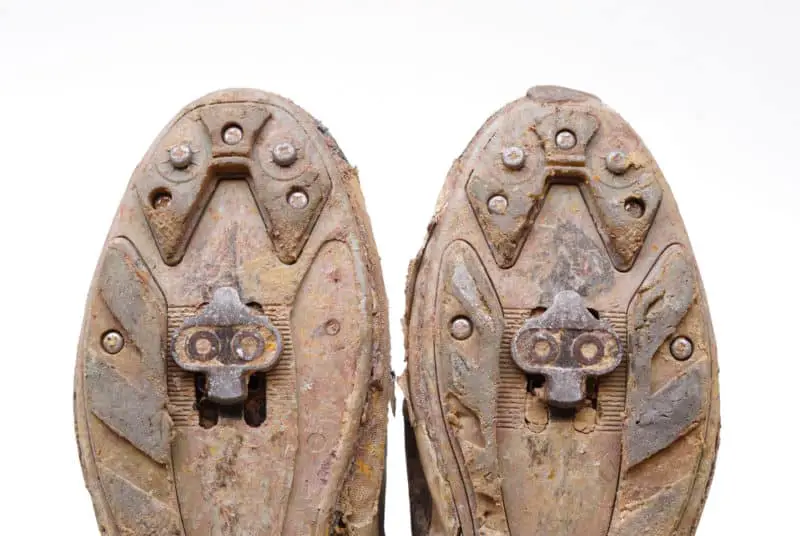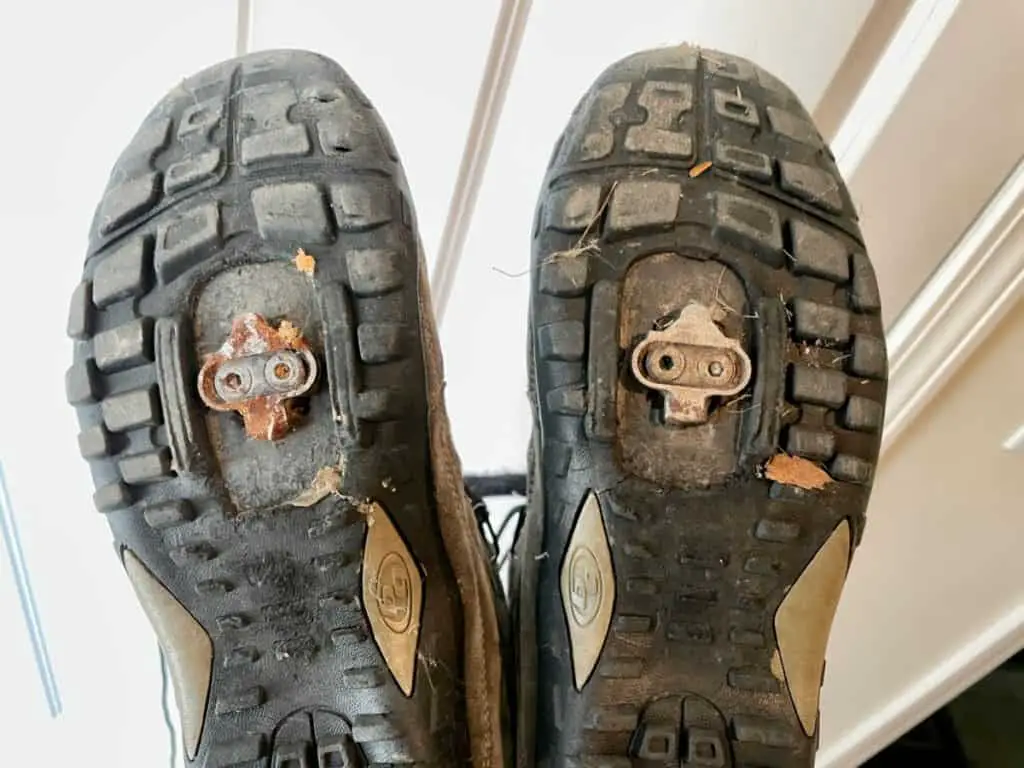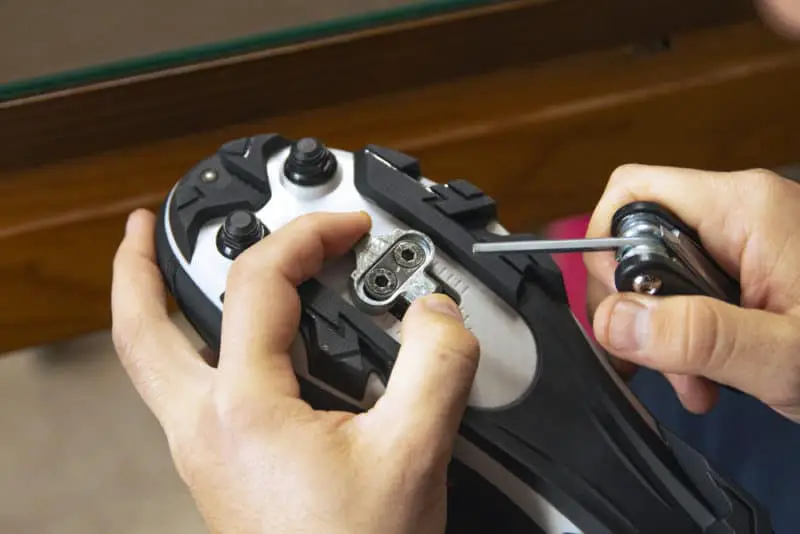No one wants to show up at a group ride with squeaky cycling shoes! If your shoes are making noise, you’ll want to do a little detective work before your next ride to figure out why your cycling shoes rattle or squeak, and what you can do to fix it.
5 Reasons for Rattling / Squeaking Cycling Shoes
Cycling shoes can rattle or squeak if the cleat plate is loose, the cleat bolts are loose, or your cleats are worn out or dirty. There could also be friction between the cleat and the pedal due to dirt and grime. Luckily, these are all relatively simple fixes, so you won’t need to buy new cycling shoes!
Let’s look at each of these 5 reasons in more detail below.

1. Dirt Between the Cleat and the Pedal
When you clip your foot into your pedal, there should be a little bit of float or wiggle room so you can get a more natural pedal stroke. But dirt, grit, or sand that gets between your shoe and the pedal can cause an unbearable squeak with every pedal stroke. This noise is from your cleat scraping over the dirt or grit on the pedal.
2. Dirty Cleats
Similarly, dirty cleats can rub against the pedal where you clip in. When you have to get off your bike and walk through muddy or dirty sections of the road, mud can get pushed up into the space between the cleats. Really caked-on dirt can make it difficult to clip into your pedals correctly.
3. Loose Cleat Plate
If you’re using cycling shoes that are both 2-bolt and 3-bolt compatible, the 2-bolt plate can become loose and wiggle around when you aren’t using it. When it does, it will cause a rattling sound as you pedal.
This is unlikely to cause any physical or danger issues. It is just the unused plate wiggling around inside your shoe: though that rattling sound can be very annoying to you and your riding mates!
4. Loose Bolts
Loose bolts can be more problematic. If a bolt comes loose, it can rattle, causing a distracting noise. It’s much worse though if a bolt falls out: these bolts hold the cleat onto your shoe. If the cleat detached from the sole of your shoe, it would remain attached to the pedal, but your foot no longer would. This could easily cause your foot to slip off the pedal and lead to an accident.
You might not notice a missing bolt if it happens to fall out at a rest stop or during a quick break, so if your cleats are rattling, be sure to check that the bolts are snug.
5. Cleats Are Worn Out
The constant clipping in and out of your pedals can cause your cleats to wear. This happens even more rapidly if you’re new to clipless pedals and it takes you a few tries to get clipped in every time. If your cleats are worn out, they may start to squeak or rattle because the edges are worn down, or the cleats won’t stay tight. The noise they make is a warning sign that they need to be replaced.

How to Fix Rattling / Squeaking Cycling Shoes
Lubricate Your Cleats
One quick fix that might solve several problems is simply lubricating your cleats. To stop the squeak, give them a quick dose of spray lubricant or even dry chain lube. This might just be a temporary fix, but it should get you through your next ride.
Lubricate Your Pedals
If you’ve tried lubricating your cleats and it just isn’t enough, you might want to add a little bit of dry lubricant to the pedal where your shoe rubs against it. This also might solve your problem temporarily, especially if you’re heading out on a ride and don’t have time for a more thorough inspection.
Tighten Your Cleat Bolts

You should check your cleat bolts from time to time to make sure they are still tight. If not, it just takes a few seconds to grab your hex wrench and tighten them up. Just be sure to avoid over-tightening so you don’t strip out the bolts.
Remove, Clean, and Lubricate Your Cleat Bolts
If your bolts still seem like they are squeaking or rattling, you may need to take them out, give them a good cleaning, and then lubricate and replace them. If dirt is caught up in the bolt threads, it could also make them more prone to loosening, which can lead to worse issues.
Use a Rubber Stopper in 2-Bolt and 3-Bolt Compatible Shoes
Some brands of cycling shoes are made to fit both 2-bolt and 3-bolt cleat systems. The problem occurs when you use the 3-bolt system, and the 2-bolt plate stays in the shoe, unused. As a result, the plate can come loose and shake around, creating a rattling sound as you pedal. This is a noisy but innocuous problem.
It’s also easy to fix. You can purchase tiny rubber stoppers to fill in these holes on the two-bolt plate to keep them from coming loose and rattling. You’ll need to remove your 3-bolt cleat, fit the little stoppers in place, and then replace the 3-bolt cleat.
Remove the Cleat Plate
In some cycling shoes, you can remove the spare cleat plate altogether. You’ll probably need to remove the insole from the inside of the shoe to access the plate. You can pull it out then replace the insole, so it stops making noise. This is the way to go if you exclusively use one type of cleat and have no need for the spare plate.
Replace Worn Cleats
You can purchase new cleats separately when necessary: something you might want to do if your cleats are worn down to the point they are making noise. Then, just swap out the old, noisy cleats for a new pair.
Clean Your Cleats
The simplest solution might be that you just need to give your cleats a thorough cleaning. If the dirt jammed into your cleats is causing them to rattle or squeak, you’ll want to try to get the dirt out without damaging the shoe.
If needed, you can use a soft brush, warm water, and a little dish soap to scrub away any dirt that is dried on the bottom of your shoe.
Examine Your Bike for Other Issues
Sometimes, the problem may sound like it is coming from the shoes, but it’s really coming from somewhere else on your bike. If you’ve checked your shoes and can’t find the problem, you may want to investigate the pedals, chain, or bottom bracket as the source of the noise.
These are all areas that are notoriously squeaky if they’re dirty or need maintenance. Getting in the habit of regularly inspecting your bike will also help you catch minor issues so you can fix them before they turn into larger problems.
